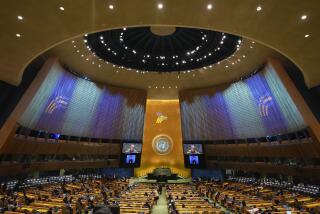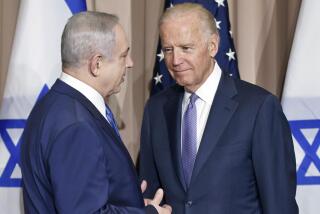The Unthinkable May Turn Into Reality
WASHINGTON — It is March 15, 1999. Tensions have been mounting for months following the disclosure of secret North Korean nuclear facilities and the testing of a two-stage missile over Japan. U.S.-North Korean talks have stalled. Food aid from the United States, Japan and South Korea has been halted; reports of tens of thousands facing famine filter out. After weeks of escalating rhetoric, North Korea unleashes a round of artillery and Scud-missile fire into the outskirts of Seoul and pours two divisions of infantry through tunnels under the DMZ. As U.S. forces begin to mobilize on barely 18-hours’ notice, Pyongyang issues an ultimatum: We have nuclear missiles targeting Tokyo and U.S. bases in Okinawa ready to launch. We seek to discuss the terms of unification with Seoul. If the U.S. or Japan intervenes in this internal Korean matter, we will level Tokyo.
The above may sound more like a Tom Clancy political thriller than a realistic vision of what the future may hold. But a cascade of recent events, from missile tests to hints of secret nuclear facilities, suggest that a 1994 accord purportedly “solving” the Korean nuclear problem has neither ended the nuclear threat nor reduced tensions. Instead, what remains perhaps the world’s most dangerous flash point may be drifting toward nightmare scenarios that diplomacy is incapable of stopping.
Administration efforts last week to deal with the threat--giving Pyongyang 300,000 tons of food for keeping its known nuclear program frozen, the hope of inspecting secret sites and more talks on other issues--suggest a wire-and-chewing-gum fix. Truth be told, current policy may have run its course. If so, the U.S. may be headed for a rerun of the confrontation that led to the brink of war in June 1994--only worse.
Pyongyang’s recent behavior raises a chilling question: Is the hope of “engaging” Pyongyang in order to bring the isolated, totalitarian regime into the global community based on flawed assumptions that make a conflict unavoidable? No less disconcerting is a White House consumed with the president’s political survival.
A harsh judgment? Well, ponder recent developments. For starters, there were those remarkable CNN images of adulatory masses and goose-stepping soldiers during Pyongyang’s lavish celebrations of the 50th anniversary of North Korea last week. All this to inaugurate Kim Jong Il as head of state--in a nation where a visiting U.S. congressional delegation estimated that 300,000 to 800,000 are starving to death annually.
More dismaying was the overture to the celebrations. Two weeks ago, North Korea successfully launched a two-stage intermediate-range missile, the Taepodong 1, that flew over parts of Japan. Pyongyang claims it was a satellite launch, which U.S. officials now say is possible. Nonetheless, the only difference between a missile launch and a satellite launch is the payload. This follows disclosures two months ago that North Korea successfully developed a 700-mile-range Rodong missile and sold the technology to Pakistan and Iran. An impressive display of technology for a failed state that administration officials privately bet is on the verge of imploding.
But most disturbing of all were “leaks” that U.S. intelligence satellites have detected 15,000 North Korean workers building what are thought to be new nuclear facilities 25 miles from the known nuclear complex at Yongbyon. Some senior U.S. officials believe this intelligence shows that, in effect, North Korea only sold us part of its nuclear-weapons program. Recent U.S.-North Korea talks were unable to resolve the issue of new and suspicious sites, but there was agreement to negotiate the matter further. U.S. officials say the nature of the sites must be clarified if the nuclear deal is to stick. If it is revealed that North Korea has continued a secret effort to develop nuclear weapons even as it claimed to have frozen its known facilities, all bets are off. Remember, there are 37,000 U.S. troops in South Korea facing 1 million North Korean troops, 11,000 artillery tubes and ballistic missiles on the other side of the demilitarized zone.
Finally, there is Pyongyang’s failure to respond seriously to a genuinely conciliatory “sunshine” policy launched earlier by South Korea’s new president, Kim Dae Jung. Though Kim pressed the U.S. to ease sanctions against the North, encouraged South Korean businesses to invest in the North and allowed unprecedented religious, cultural and tourist exchange, Pyongyang has, so far, refused calls for high-level talks on national reconciliation.
All this calls into question the logic of the 1994 nuclear accord and, indeed, whether it is possible to do business with North Korea at all. The idea undergirding the agreement was more than to halt Pyongyang’s nuclear-weapons program. The United States and South Korea hoped that the accord was a breakthrough leading to an opening up of the world’s most closed society, to North Korea’s reform of its moribund economy and more steps to reduce tension and peaceful reconciliation with South Korea. Short of that, the accord would still buy time: North Korea might collapse or at least become militarily weaker. To North Korea, the accord was viewed as something akin to Richard M. Nixon’s opening to China: a strategic shift turning the U.S. from adversary to friend--or at least a life-support system.
It hasn’t turned out that way, and there is plenty of blame to go around. But Washington may have more than its share. The 1994 accord commits the U.S. to move toward normalizing relations and to ease restrictions on trade and investment. Not only has the United States not done so, but the Clinton administration has, in effect, moved the goal posts, telling Pyongyang that relaxing sanctions requires more concessions. Additionally, the U.S. fell behind in promised shipments of fuel oil to North Korea, and the construction of two light-water nuclear reactors is years behind schedule.
The benign interpretation is that this is all a bargaining tactic. Over the past year or so, an increasingly desperate and frustrated North Korea has turned to its old bluster of nuclear threats. Its missile firings in part may have conveyed such a message: Put something serious on the table if you want to halt our missile programs.
But there is reason to wonder if a much darker interpretation is warranted: What if U.S. assumptions about buying time are completely wrong? As its lavish celebrations illustrate, North Korea is not about to collapse. What if the North Korean military has been buying time? While the U.S. has been feeding the technicians, they have been turning unaccounted-for plutonium into nuclear bombs and developing missiles to deliver them. What if the North’s ultimate trump card is not trading military threats for economic gifts but, rather, nuclear blackmail to force Korean reunification on terms acceptable to it? This is a possibility that cannot be ruled out.
Where does this leave us? Congress and the public are rightfully questioning why taxpayer money should be given to this repressive regime that is popping champagne corks and building missiles as its people starve, and, no less, is possibly cheating on its commitments. But it is too soon to conclude that military conflict is the unavoidable outcome.
The next step must be to hold higher-level talks to gain access to the suspicious newly discovered sites. If they are nuclear facilities under construction or operating, they must be halted immediately and made accessible to full inspection. If it is not possible to unambiguously conclude that this is not a covert nuclear program, the nuclear accord should be terminated and a policy of benign neglect initiated.
If Pyongyang demonstrably cooperated, the U.S., South Korea and Japan should make one last good-faith effort to put a grand bargain on the table. North Korea would receive substantial economic aid and investment if it gives up (in a verifiable manner) its missiles and chemical and biological weapons, and begins reducing its conventional forces in tandem with South Korean efforts.
The tragedy of U.S. policy, so far, is that we are drifting toward conflict without having honestly tested Pyong-yang’s intentions by offering North Koreans a road map for a soft landing that meets their legitimate interests if they meet ours. But if Pyongyang failed to respond credibly to such an offer, it would be time to begin thinking the unthinkable.
More to Read
Sign up for Essential California
The most important California stories and recommendations in your inbox every morning.
You may occasionally receive promotional content from the Los Angeles Times.










